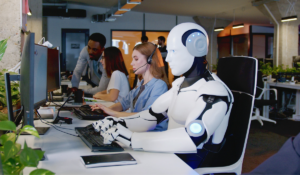Brain-reading robots are sophisticated robotic systems meant to read the brain by monitoring changes in electric impulses. The brain reading robot’s central unit is a brain-computer interface based on Electroencephalography (EEG), a technology for measuring electrical activity in the brain.
How Technology is Used in Brain Reading Robots

Technology in brain reading robots centers around the brain-computer interface, with Electroencephalography (EEG) serving as its basis—a technique for determining brain electrical activity. Mind-reading robots utilize EEG signals to discern various brain signals corresponding to body movements and intentions, making this technology human-centered and applicable in household tasks, commercial assignments, and security.
To read the human mind, tracking the electrical activity in the brain is essential. This information can be enhanced by combining it with muscle electrical activity, enabling the detection and understanding of brain signals. The key to brain-reading technology lies in allowing humans to convey their intentions to the computer using their thoughts.
Emotions, desires, attentions, intents, and beliefs constitute the five fundamental categories of human mind-reading. Brain reading robotic technology employs complex algorithms, decoding electric brain impulses and converting them into spatial representations through brain mapping. Brain neurons generate electric signals, monitored via electrodes inserted on the scalp.
Applications in Various Fields
The medical field has seen significant benefits from advanced brain-reading technology. Their remarkable efficiency, accuracy, and precision make them invaluable in performing complex surgeries and utilizing precise surgical tools.
These robots are also adept at follow-up treatments, wound dressing, suturing, and conducting minimally invasive procedures in hospitals. As a result, their widespread adoption is expected to drive revenue growth in the medical industry.
The education sector, especially for online students, witnesses a surge in the use of mind-reading robots as robotic instructors. These robots monitor students’ attention levels and emulate strategies employed by human teachers to maintain their engagement, effectively putting an end to distractions during online classes.
For instance, a recent experiment at the University of Wisconsin-Madison showcased an intelligent teaching system utilizing virtual teachers, which are mind-reading robots capable of detecting lapses in students’ attention and employing tactics to refocus their attention on online instruction.
The Future of Brain Reading Robots

While brain-reading robots can decode brain signals, they are not intended to replace human interactions. Instead, they serve as useful tools to simulate human interactions. Ethical questions regarding the use of this technology to read a person’s mind still need to be addressed before widespread adoption can occur.
Recent advancements in brain-reading technology have showcased promising developments. Such technology could also be applied to control wheelchairs, enhancing mobility and independence.
The Potential Beyond Disabilities
Beyond assisting individuals with disabilities, brain-reading robots hold the potential to revolutionize various aspects of human life. As research progresses, scientists are exploring new applications that extend far beyond medical and physical limitations.
One exciting area of exploration is the integration of brain-reading technology into everyday devices and services. Imagine a world where brain-reading robots can understand and anticipate an individual’s preferences, making personalized recommendations for entertainment, shopping, and other activities.
While these advancements offer convenience and efficiency, it also raises concerns about privacy and the potential manipulation of personal data.






















































